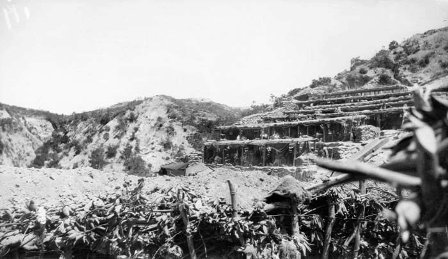29 July 1915
ANZAC - Admiral Sir Roger Keyes, Admiral of the Fleet, Royal Navy - After an official visit to General Birdwood at his Anzac HQ, Keyes had some free time to spend before the destroyer was due to leave. With General Godley as a guide, Keyes went into some of the most dangerous areas of the Anzac battlefield, and there met Lieutenant Colonel Malone for the first time.
 "29th July - We first went up the trenches which we visited the first day with Sir Ian; then they were being sniped all the time, and one had to keep one's head down, but now they are unoccupied; we have extended so much further. Then we went up 'Shrapnel Valley', where all the casualties occurred that first night - which so disheartened the men - it is still dangerous, General Bridges was mortally wounded there, but everything is so well worked now, one goes up by communication trenches - we were not taking any risks. Everyone carries an anti-gas mask - Godley would not take his, because I hadn't one! They haven't started gas yet."
"29th July - We first went up the trenches which we visited the first day with Sir Ian; then they were being sniped all the time, and one had to keep one's head down, but now they are unoccupied; we have extended so much further. Then we went up 'Shrapnel Valley', where all the casualties occurred that first night - which so disheartened the men - it is still dangerous, General Bridges was mortally wounded there, but everything is so well worked now, one goes up by communication trenches - we were not taking any risks. Everyone carries an anti-gas mask - Godley would not take his, because I hadn't one! They haven't started gas yet."
"Then we worked our way to 'Quinn's Post', it is the sight of Anzac, but they won't take General or Admiral visitors there. However Godley goes every other day and Birdwood nearly as often, and I wanted to see it. It really is wonderful, it is on the crest of the cliff, with a staircase cut up to it, the steps bound with brushwood traverses; then a plateau, with tunnels and galleries in all directions. Mining and counter-mining goes on all the time. The sight is a crater, which was blown in by a huge mine explosion some weeks ago. During the night the Turks built a regular fort in the crater, and from there drove us out of our fire trenches, and nearly down the hill with bombs. We replied, and made it impossible for them to live in the fort, which was in turn blown up by mining - but the fire trench was untenable by either side, about ten yards from our second line, and 20 yards from their front trenches."
At Quinns Post, Keyes and Godley were joined by Lieutenant Colonel William Malone, CO, Canterbury Battalion, NZEF. Keyes wrote of Malone:

"He is a fine fellow and simply loves it. he took me into the crater - pitch dark except for slits - it is held by four rifles, they said they could hear the Turks working, and had just sent for the miners to come and listen and countermine. The Australian miners are quite wonderful, and can beat the Turks 99 times out of a 100.
Then we went along the fire trench - protected against bombs by rabbit wire overhead, barbed wire and very deep. Bombing was going on all the time, and one could see the parapet of the Turkish trench very clear, only 20 yards away. I asked a man whether he had a shot that day, and he said 'three'. A Turk had been very saucy and had put up his head three times, he thought he has put him to sleep. Then another man told us that 'just here' a man had put his head back 'like this' doing the same himself, and got shot through the head which killed him, only two or three hours before; a machine gun had done it. Then to show me, the man threw a bomb, and promptly the machine gun went rat-tat-tat against the parapet, ripping into the wood holding the rabbit wire. Standing as we all were, it was perfectly safe, but men will get careless. I asked whether they liked it? They said 'better than fatigues'. I did enjoy myself, and I promise you ran no risks."
"SOURCE:
The Naval Memoirs of Admiral of the Fleet, Sir Roger Keyes, 1910-1915 (Thornton Butterworth Ltd; London 1934), pp.373-375
